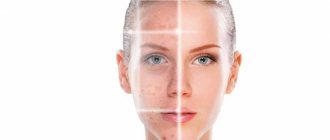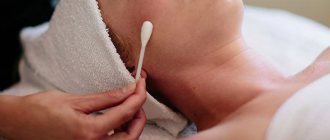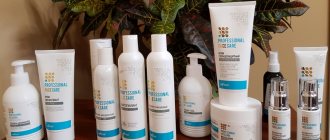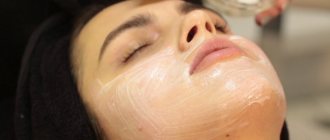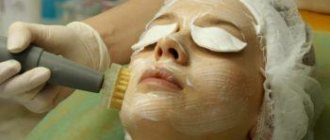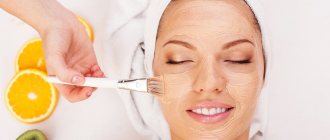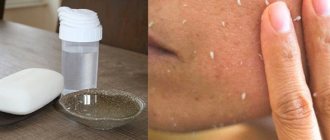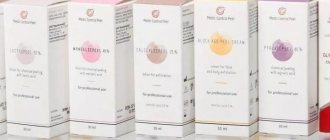Superficial and medium chemical peels
Principles of action and types of chemical peelings - chemical peeling is based on the action of chemical agents (most often acids) and allows you to remove dead skin layers at the same chemical peeling depth, while simultaneously stimulating the regeneration of young cells.
Today, this method of aesthetic medicine still remains one of the most popular. The popularity of chemical peeling is due to its high efficiency, combined with a relatively low cost. Unlike their physical and mechanical counterparts, chemical peels are simple to perform and do not require expensive equipment. If they are performed according to indications and, most importantly, by a cosmetologist, their results are truly impressive! Principles of action and types of chemical peels remove dead skin layers by stimulating the regeneration of young cells.
Depending on the depth of skin damage, all chemical peels are divided into superficial (glycolic peeling, milk peeling, retinoic peeling, pyruvant peeling) and medium. Superficial ones have an effect within the stratum corneum of the skin, middle ones penetrate the skin to the entire depth of the epidermis without damaging the basement membrane, and deep ones affect the basement membrane - partially or completely. It should be noted that deep chemical peeling is a type of surgical operation. And it is almost never used in the practice of a dermatocosmetologist of aesthetic medicine.
Any chemical peel is essentially a chemical burn to the skin. Correct pre-peeling preparation and the use of modern peeling compounds can minimize the risk of complications. Strict control of the depth of damage and creation of optimal conditions for subsequent skin rehabilitation. The Medic Control Peel line includes not only preparations for professional peeling. But also a full range of additional products for pre-peeling preparation and home skin care during the rehabilitation period. And also to maintain treatment results. With such a reliable arsenal at your disposal, you can perform chemical peels in summer and winter.
Indications for use:
- skin aging (wrinkles, decreased turgor, sagging, microrelief disturbances);
- hyperpigmentation of various etiologies;
- problematic skin (acne, rosacea, seborrheic and actinic keratomas, ichthyosis, xeroderma);
- post-acne scars and other etiologies.
Chemical peeling procedure
Any chemical peel involves three stages:
- Pre-peeling preparation;
- Peeling procedure;
- Post-peeling rehabilitation.
Pre-peeling preparation is a very important stage that determines the depth and controllability of the peeling and its effectiveness. It is carried out at home and ensures equalization of the thickness of the stratum corneum, stabilization or inhibition of melanogenesis, and also stimulates skin regeneration (especially aging skin).
A number of techniques have been developed for chemical peeling, each of which has its own characteristics. The peeling composition can be applied to the skin using a brush, gauze pads, cotton pads or cotton swabs. The time of its exposure is determined by objective factors (erythema, swelling/pastyness, frost effect). So and the patient’s subjective sensations (pain, burning). A clear knowledge of the peeling protocol helps to complete the procedure quickly and confidently.
The goal of post-peeling rehabilitation is to level the patient’s subjective discomfort and prevent side effects and complications. Anti-inflammatory and antioxidant therapy, stimulation of regenerative processes and protection of the skin from adverse exogenous factors.
The Medic Control Peel line contains a wide range of special products that meet all of the above requirements.
Chemical peeling is an effective method for correcting involutional changes in the skin and atrophic scars. Milk peeling is indispensable for skin whitening in order to improve its texture. Knowledge of the peculiarities of the interaction of a chemical agent with the patient’s skin and methods for determining the depth of penetration of the peeling composition allows one to achieve excellent results and minimize the risk of complications. Another advantage of the technique is the ease of its execution by a cosmetologist.
Types of Chemical Peels
The effect of chemical peeling depends on the depth of skin damage. With increasing depth, the effectiveness of the procedure increases, but at the same time the frequency of possible complications, the duration and complexity of the rehabilitation period increases.
The choice of chemical peel depends on:
- skin condition;
- features of healing of the wound surface;
- areas of expected impact;
- the type of chemical agent included in its composition, its concentration and pH;
- forms of applied peeling composition (gel, lotion, cream, etc.);
- technique and number of applications;
- quality of patient skin preparation.
Based on an assessment of the nature and extent of age-related and pathological changes, taking into account skin type. Classification of signs of photoaging and other objective data. The specialist selects the optimal peeling composition and the depth of its effect, stimulating the regeneration of young cells.
Preparation
There are two types of skin preparation for the medium peeling procedure.
Preparation using special cosmetics. First of all, the face is cleaned, and then you need to use special care cosmetics with glycol for three weeks. This way you can prepare your face for the procedure.
It is important to prepare for such a procedure
Preparation by exfoliating the skin. This method is carried out in small quantities - just a couple of steps. Peeling is used to treat clean skin. In this way, the skin is prepared directly for medium peeling.
Interesting ! To prevent the appearance of herpes seven days before the peeling procedure, you need to start taking antiviral medications.
It is worth starting taking antiviral drugs early
Peeling in summer
✹❀
There is still an opinion that chemical peelings are impossible during periods of high solar activity. Indeed, in some cases it is undesirable to perform peeling in the summer. However, if you choose the right chemical agents and home care products. Then, by performing summer peeling, cosmetologists can successfully solve a number of aesthetic problems in the summer.
Criteria for choosing the type of chemical peeling:
- indications and planned depth of skin damage;
- mechanism of action of the peeling composition;
- contraindications for peeling;
- the patient’s lifestyle (bad habits, social status);
- presence of concomitant diseases;
- the patient's real wishes;
- patient requirements for the terms and conditions of the post-peeling period.
Popular questions
Is it possible to get rid of acne with peeling?
There is no need to expect that this procedure will remove acne in one go. You can only help eliminate the problem.
What types of hardware medium peeling are there?
You can use laser or grinding as another type. You can also undergo dermabrasion.
For what reason is it recommended to exfoliate in autumn and winter?
This is due to the fact that the sun is least active at these times of the year. The effect of the sun may negatively affect the skin after the procedure. But even in winter it is worth using protective creams.
Procedures are carried out only when there is little sun activity
Glycolic peeling
✹❀❄
remove dead skin layers by stimulating the regeneration of young cells aesthetic medicine by a cosmetologist
Glycolic peeling is the most common chemical superficial peeling based on alpha hydroxy acids. Glycolic acid has the most active molecule of all AHA acids, due to which preparations based on it have a pronounced exfoliating, stimulating and antioxidant effect. Peeling with glycolic acid is used to solve a wide range of aesthetic problems: age-related manifestations, hyperpigmentation, skin texture disorders, acne and post-acne scars. The concentration of glycolic acid in AHA peels varies from 30% to 70%, but pH plays an equally important role here. The most effective glycolic peels are characterized by a pH value below 2.0, which implies the mandatory use of a neutralizing composition in the procedure. In addition to glycolic peels based on pure glycolic acid, there are combined glycolic peels based on drugs that include acids such as phytic, kojic, lactic, and salicylic.
Thanks to various combinations of ingredients in peeling products, a specialist has the opportunity to work on a particular problem, taking into account the individual characteristics of the patient as much as possible. It should be noted that all glycolic peels based on alpha hydroxy acids are highly effective, easy to perform and have a short rehabilitation period. The effect of glycolic peeling has been well studied and can be accurately predicted. This makes glycolic peeling extremely popular among specialists. So it is among clients of cosmetology clinics and cosmetologist doctors. Principles of action and types of chemical peels remove dead skin layers by stimulating the regeneration of young cells.
What are the nuances before the procedure?
Although the medium peeling procedure has a wide range in terms of indications for its implementation, there are a number of features.
This procedure will not help remove all scars and scars, it will simply make them less noticeable. This is due to the fact that peeling affects only certain layers and boundaries of the defect.
The procedure makes defects less noticeable due to the specific nature of the peeling.
Medium peeling will not be able to rid you of facial wrinkles and those that appear in the mouth and eyes. However, medium peeling works well against skin pigmentation. It is worth remembering that people who are predisposed to the appearance of such spots may encounter them again some time after the procedure. This will happen either in new areas or in place of old ones.
You can get rid of severe skin pigmentation
Interesting ! The above process can be provoked by the sun and various damage to the skin and epidermis.
To permanently remove acne, you should use a medium peel in combination with medication treatment. This solution will help destroy the main source of the disease. The peeling procedure will make the pores smaller and reduce the production of sebaceous glands.
You need to combine peeling and medications if you want to get rid of acne
Milk peeling
✹❀❄
Other popular peeling preparations are formulations based on lactic acid. They are characterized by high penetrating ability, which allows their use in patients with severe hyperkeratosis caused by both unfavorable exogenous factors and skin aging. Due to the fact that lactic acid is a component of the natural moisturizing factor of the epidermis. Milk peeling interacts very delicately with the skin and maintains a high level of moisture. Recommended for the correction of cosmetic defects, dry and aging skin, aesthetic medicine.
❄
Retinoic peels belonging to the superficial category have gained particular popularity recently. Retinoic peels are also known as “yellow peels” or “weekend peels” (due to the short recovery period). The mechanism of action of retinoic peels is fundamentally different from the mechanism of action of other peeling agents. The retinoids included in the “yellow peeling” do not damage the skin, do not destroy living cells, and do not coagulate proteins. They interact with specific nuclear receptors of cells. Principles of action and types of chemical peels remove dead skin layers by stimulating the regeneration of young cells.
These receptors have been found in basal keratinocytes, melanocytes and fibroblasts. Thus, as a result of the effect of retinoic peels on the epidermis, the level of mitotic activity of basal keratinocytes increases, the processes of differentiation and keratinization, as well as melanogenesis are normalized, the synthesis of epidermal lipids and components of the intercellular matrix of the dermis is activated and stimulated, and the number of atypical cells is reduced. As a result, skin aging slows down, its texture improves, its relief is evened out, and a pronounced rejuvenating and brightening effect is achieved. In addition, yellow peel retinoids have a powerful antioxidant effect. Histological studies have shown that the stimulating effect of retinoic peels on the cellular structures of the skin persists for 4 months after the last application of retinoids. Other important reasons for the demand for retinoic peels are their atraumatic nature and high safety of use, a short post-peeling period and an extremely low rate of complications. Therefore, retinoic peeling can be carried out in the summer.
Reviews
Considering the statistics and reviews of the female half of the population, the most popular facial peels remain superficial ones, which are accompanied by painless sensations, have a short recovery period and are considered budget procedures. If you focus on Moscow, the skin cleansing process is estimated at 3000–6000.
According to women's reviews, deep facial peeling in the salon can be compared with the result after surgery - plastic surgery for rejuvenation.
And the new laser peeling in current cosmetology, according to clients, on the contrary, is ineffective in the fight against wrinkles and pigmentation. After the swelling disappears, the recovery period of the fold ends and the dark formations take their original place.
Almond peeling
✹❀❄
Superficial almond peeling is in constant demand among clients of beauty salons. This is due to its many benefits. Almond peeling has a moisturizing, stimulating and antioxidant effect and is ideal for combating the initial signs of skin aging. Professional almond peeling Medic Control Peel has an additional antimicrobial effect, therefore it is often used to treat problem skin with signs of acne. The mandelic acid molecule is quite large, which determines the gentle effect of the peeling composition on the skin and almost completely eliminates the risk of developing post-peeling hyperpigmentation. Delicate almond peeling is recommended for year-round use for patients with skin of any type. Including dark skin by stimulating the regeneration of young cells of aesthetic medicine by a cosmetologist.
Salicylic peeling
✹❀❄
Salicylic acid was first isolated from willow bark in the 19th century. Having a pronounced keratolytic effect and high penetrating ability, this beta-hydroxy acid causes peeling of the epidermis. At the mouth of the hair follicle, thereby preventing the formation of comedones. Salicylic acid has a powerful anti-inflammatory and antiseptic effect, reduces the activity of the sebaceous glands. But it does not penetrate into the deep layers of the skin and causes virtually no side effects. Peels based on pure salicylic acid are recommended for patients with thick and liquid seborrhea. Acne, initial and moderate signs of age-related skin changes, photoaging, hyperpigmentation, wrinkles, skin microrelief disorders. They are also used to stimulate exfoliation in ichthyosis and psoriasis. Salicylic acid is included in many peeling preparations. And thanks to its excellent ability to “loose” the stratum corneum of the skin. Salicylic peels are often used in protocols for other chemical peels (for example, retinoic). To improve their penetration and obtain a more pronounced result of aesthetic medicine by a cosmetologist.
✹❀❄
Jessner peeling is a classic combined mid-superficial peeling, the activity of which is determined by the ingredients it contains. Lactic and salicylic acids, as well as resorcinol. The effectiveness of Jessner peeling depends on the procedure technique: the more layers of peeling composition are applied. The deeper the penetration will be. This allows the doctor or cosmetologist to individually select the number of layers - from 1 to 8. For each specific patient, thus achieving an optimal result. Peeling causes active large-plate peeling and has a good keratolytic effect. Due to this, it is effective for hyperkeratosis, pronounced age-related changes and skin texture disorders.
Professional opinion
I. Dorofeeva, cosmetologist
“Most peeling methods can be quite dangerous, sometimes leaving the skin feeling like paper thin. To prevent the situation from getting worse, you should contact an experienced specialist. For the first time, you should still think carefully and choose a less aggressive peeling procedure. Medium peeling should be neglected for now. Besides this, there are other very effective procedures that may be enough to achieve results.”
Not all doctors have a positive attitude towards this procedure
❄
The principle of action of TCA peeling is based on the pronounced keratolytic and stimulating effect of trichloroacetic acid. The depth of penetration of the peeling composition is determined not only by the concentration of acid in it. But also the number of layers applied to the skin. Moreover, as soon as the application of peeling is completed, its penetration into the tissue also stops. Because trichloroacetic acid is quickly neutralized in the skin layers, causing protein coagulation. TCA peeling ensures renewal of the epidermis, stimulates repair and metabolism processes, which helps improve skin texture. As well as correction of wrinkles, various types of scars (post-traumatic, post-operative, post-acne) and other disorders of the skin relief. Trichloroacetic acid does not have a systemic effect on the body.
Results
Medium peeling is a procedure that helps smooth out skin problems, as well as get rid of the psychological barrier that may arise due to appearance. Peeling procedures will give a bright effect for a long time. Moreover, peeling can forever save you from annoying procedures for applying creams and other cosmetics. It is best to resort to using this procedure as an adult, since from about 25 years of age, the body’s recovery processes already slow down.
